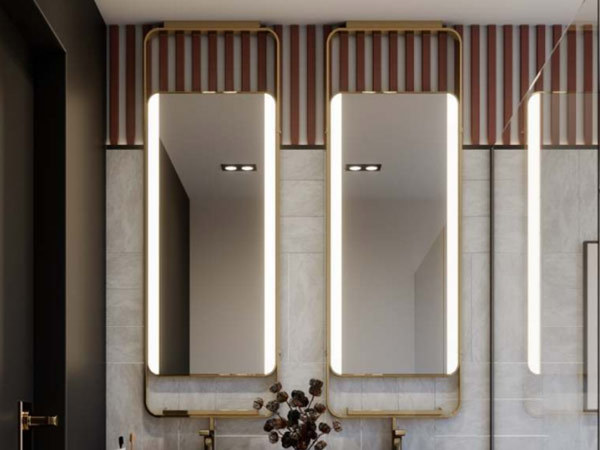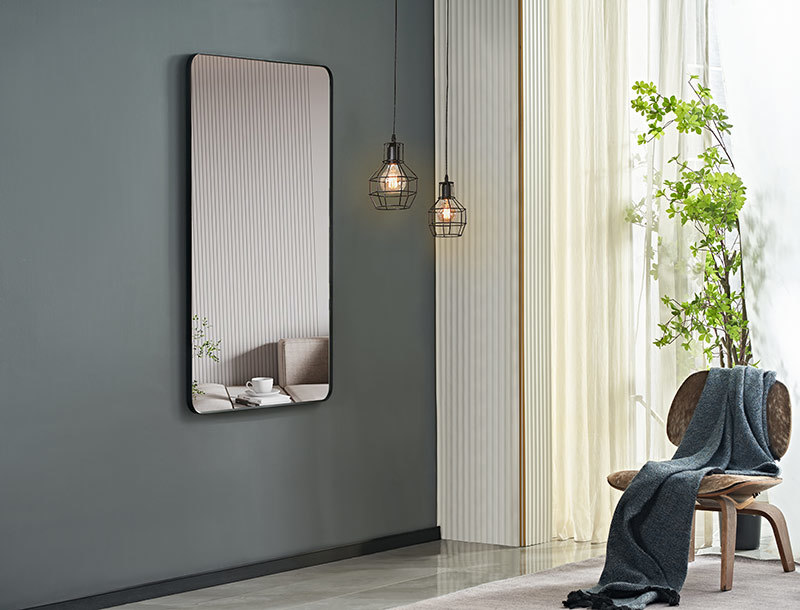How to better use decorative mirrors to match wall soft decoration elements and decorative mirrors?
Decorative mirrors are a very important form of artistic expression in wall decoration. Since ancient times, there has been a saying that "using copper as a mirror can straighten one's clothing", but many people still rely on the most primitive functional basis for the use of decorative mirrors. In fact, in home space, decorative mirrors with different shapes and frame materials also have their unique decorative effects. Iron frames, leather frames, and various natural materials, combined with circular, square, polygonal and other forms of expression, enrich the artistic image of decorative mirrors. And this mirror material also replaces ancient mirror materials such as gold, silver, crystal, and bronze with glass plated mirrors, antique mirrors, and polished mirrors. Decorative mirrors are mainly divided into two types: framed mirrors and frameless mirrors, with frameless mirrors being more suitable for use in modern minimalist spaces.

1. Classification of decorative mirror shapes
Decorative mirrors come in various shapes such as circles, squares, polygons, and irregular shapes, each with its own uniqueness and can produce different visual effects.
There are two types of circular decorative mirrors: regular circular and elliptical, and their appearance can give people a comfortable feeling. A circular decorative mirror with a simple frame can create a concise and clear atmosphere in the space, while a circular decorative mirror with a lace frame appears artistic. Both gear style and flower style circular decorative mirrors can play a good decorative role. Oval decorative mirrors pay more attention to practical effects, and their shape not only brings a curved aesthetic to the interior, but also plays a role in saving space to a certain extent.
Square decorative mirrors have both decorative and functional properties. Long rectangular mirrors have a large reflective area and can be used for decoration and reflection of light, making them easy to match with the surrounding environment. In many modern minimalist spaces, decorative mirrors of this shape can be seen.
Polygonal hanging mirrors have clear edges and corners, beautiful lines, and a simple and modern overall style, making them a good choice for home wall decoration. Some polygonal hanging mirrors come with metal trim, appearing luxurious and exquisite.
Irregular shaped decorative mirrors are more artistic than circular decorative mirrors, and have a larger space for imagination, rendering a stronger spatial atmosphere
2. Application rules of decorative mirrors
Frame selection
A minimalist decorative mirror with edges usually perfectly complements slim legged furniture. Gold-plated decorative mirrors are very suitable for placing with ink, which can enhance the spatial aura. Antique mirrors with antique patterns are highly decorative, and their carefully crafted frames can reflect the entire space. Some decorative mirrors are decorated with patterns made of a circle of tree branches on the periphery, blending a natural and fresh atmosphere in a modern design.
Space utilization
Due to the fact that decorative mirrors can illuminate the food on the dining table, stimulating the taste nerves of diners and increasing their appetite, they are very suitable for use in restaurant spaces. In addition, decorative mirrors are also commonly used soft decoration elements in neoclassical, Chinese, European, and modern style restaurants. In the suspension position, it is generally sufficient to choose a more prominent and spacious area. If a sideboard is installed in the restaurant, decorative mirrors can also be hung above the sideboard.
The decorative mirror in the bedroom can not only be used as a dressing mirror, but also play a role in enlarging the space, thereby resolving the oppression of a narrow bedroom. You can also design a set of small decorative mirrors on the wall of the bedroom, which not only expands the space but also makes the decoration of the bedroom more personalized and eye-catching.
Decorative mirrors, as a necessity for bathroom walls, seem to dominate their functional role, so many people overlook their decorative and spatial effects. In fact, with clever design, the mirror can bring unexpected decorative effects to the bathroom. Decorative mirrors not only extend space visually, but also enhance brightness. Decorative mirrors in bathrooms are usually installed above the washbasin to beautify the environment and facilitate makeup organization.
Frame selection
Installing decorative mirrors on a wall parallel to the window can introduce the scenery outside the window into the interior, increasing indoor comfort and naturalness. If the conditions are limited and the decoration cannot be installed in this position, the color, shape, and type of the reflector should be carefully considered to avoid making the indoor space appear disorderly. In addition, you can also hang a decorative painting opposite the decorative mirror or simply use a white wall to increase the depth of the room.
Generally speaking, the width of decorative mirrors should be at least 0.5m. Large decorative mirrors can range from 1.7 to 1.9 meters. If you want to use decorative mirrors as the decorative focus in the space, you should hang them at least 1.5m above the floor. The hanging position of the small decorative mirror should be at the eye level, as being too high or too low may affect daily use. The recommended distance for viewing decorative mirrors is about 1.5m. It should be noted that artificial lights should not be directly directed towards the decorative mirror.
LATEST NEWS
In addition to dressing up and enlarging space, mirrors can also be used in rooms with insufficient lighting to refract light and increase daylighting. Mirror design can achieve irreplaceable effects in different areas!
Intelligent mirror display screen brings black technology home life interactive experience
Smart home products can be equipped with intelligent voice assistants, such as the popular intelligent mirror display screen, which is an artificial intelligence assistant to enhance the human-computer interaction experience.




